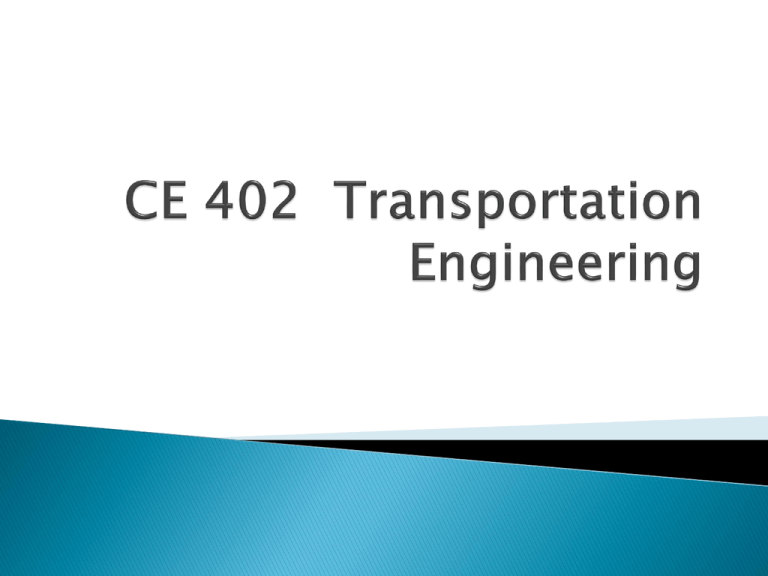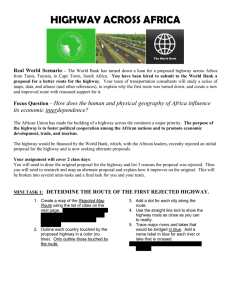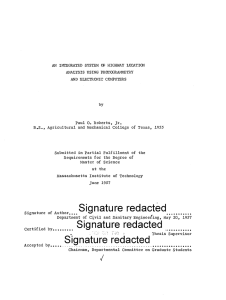desk study of available data - wec civilians
advertisement

Life in communities has changed over the years. One of those changes is in transportation. Transportation is a way of moving people or things from one place to another. Land Water Air There are three main elements of automobile transportation: The road users (Drivers and pedestrians) The vehicle The road way and geometric design LOCATION SURVEY AND CONTROLS Art of observing and making measurements of relative portions of natural and manmade features on the surface of earth and plotting these measurements to some suitable scale to form a map. Highway surveys involve measurement and calculation of distances, angles (horizontal and vertical) and elevations. The data is then used to form a base map with contour lines and longitudinal crosssections. Three major categories 1. Ground Surveys Basic equipment is used for location survey Measuring Tape. Levels. Theodolite. Electronic distance measuring devices (EDM’s). 2. Remote Sensing Measurement of distances and elevations by using devices located above the surface of earth. Data is collected through airplanes and satellites using global positioning systems (GPS). Photogrammetry (data is obtained with the help of aerial photographs) is the most commonly used technique. 3. Computer Graphics Available/collected data is compiled and stored in the electronic form. Photogrammetric and general survey data is combined digitally with the help of softwares. The files can then be plotted in the form of maps. Location controls are basically the factors that effects the selection of location of a highway Major factors are: Topography. Soil Characteristics. Environmental factors (noise and air pollution). Economic factors. Highway location process have four phases Desk study of available data/information Reconnaissance survey Preliminary location survey Final location survey Available data in the form of reports, maps,aerial photographs and charts is studied. Data is obtained form government authorities e.g. transport department (NHA), geological survey of Pakistan etc. Similarly, information is required to be obtained on hydrology, mining, agriculture and weather. Data is obtained on the following characteristics: Engineering (topography, geology, traffic volume and climate) Social (land use trends and zoning) Environmental (air, noise and water pollution, wildlife, historic and archaeological sites) Economic (construction cost, agricultural, commercial and industrial trends) “Reconnaissance is the process of identifying several possible routes & evaluating the feasibility of these routes for a highway between specific points” Aerial photographs are often used for the purpose, especially for rural areas. Feasible routes are identifies by keeping in mind the following factors Terrain and soil conditions. Serviceability of route to industrial and residential areas. Crossing of other transportation facilities like rivers, rail and highways. Route directness. Identification of control points for each feasible/selected route. Routes are then plotted on a map. The position of the feasible routes are set as closely as possible by Establishing all control points. Determining preliminary vertical and horizontal alignments of each control point Economic and environmental feasibility of the routes The best route is then selected as the preliminary alignment for the highway. Initial cost of the project and future economic effects Road user cost Construction cost Road user benefits Economic drawbacks from the project Information also helps in deciding the type of highway for a particular route. Environment Includes plant animals Human community Effects on quality of life for all (animals and human being) An environmental impact statement should be submitted which should include Available alternatives Assessment of all positive and negative impacts Short and long term effects Unavoidable adverse environmental effects Use of natural resources Each route should be studied e.g. Positive and negative effects of at grade or grade seperated intersection. Detailed layout of the selected route is carried out at this stage Centreline of the road. Horizontal and vertical alignment. Property lines. Intersecting roads. Position of structures and drainage channels. Factors that effect location of highway in urban areas Connection to local streets (which street to connect,traffic flow) Right-of-way acquisition (land cost, road on elevated structures, noise and aesthetics) Coordination with other transportation systems (integrated system, public transport) Provisions for bicycles and pedestrians (sidewalks,crosswalks, traffic control devices, ramps, bicycle path)





